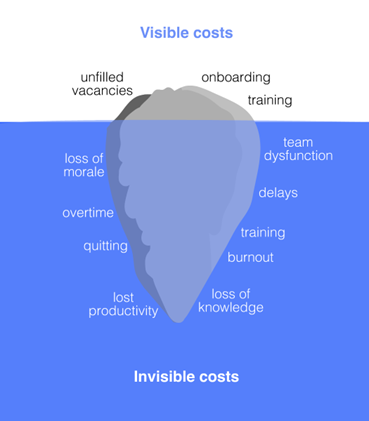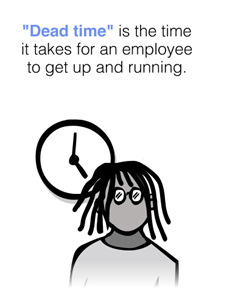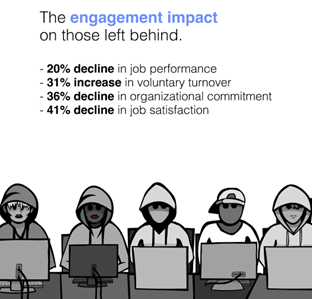The Real Cost of Employee Disengagement

By Fiona Passantino
Whether by layoff, reorganisation or attrition, many companies underestimate the true cost of losing talent, which is the ultimate result of employee disengagement. This loss goes beyond the obvious visible expenses that comprise pay-outs, fees, recruiting and training new employees, but include dips in productivity, poor customer service, low morale and the gradual depreciation of culture. When we truly see the full price of our disengagement, we are more motivated to focus on the employee experience.
STRESS, BURNOUT AND ATTRITION
Long after Covid, we are still finding ourselves in a global workplace crisis defined by employee stress, burnout and attrition. Engagement numbers continue to fall by two points per year. It was at 32% in 2022 and numbers for 2023 may be even lower[i]. This is mirrored by employee disengagement, which continues to grow by two points per year, winding up at 18% in 2022 – the highest in 20 years[ii].
Being disengaged at work isn’t fun for anyone, neither employee nor leadership. But fun aside, there is an actual monetary cost to disengagement which significantly impacts a company’s bottom line. Gallup estimated that the true cost of disengaged employees was as high as $550 billion in the US alone[iii].
Where do these costs come from? The first obvious place to look is the cost of attrition: workers who are disengaged tend to quit, and for the ones who stay, performance goes down. The global annual quit rate is now at 3%, a 20-year high[iv].
Companies that engaged in large-scale layoffs saw a 20% decline in job performance, a 41% decline in job satisfaction, a 36% decrease in organisational commitment and a 31% increase in voluntary turnover[v]. A layoff culture leads to a degradation of culture and trust. The result? More attrition of high-value employees.
VISIBLE COSTS OF FILLING A SEAT
The cost of replacing an employee varies by industry, job role, location, and level of expertise required for the position. Generally, it’s about 6 to 9 months of salary[vi].
Each new leaver requires increased efforts by HR teams over an extended period of time, well beyond the typical recruit-embed cycle. This is a heavy lift given the current tight labour market over 2022-2023; talent is harder to attract and retain.

RECRUITMENT
Advertising the position, screening candidates, interviewing, and selecting the new hire is an obvious, visible cost.
Filling the average mid-senior team lead seat costs about 30 hours of an (external) recruiter’s time, a flat fee payment for job ads on multiple platforms, signing bonuses for the candidate, bonuses for the reference (if internal) or of the middleman (if external), national and international background checks, and pay-outs to head-hunters for the acquisition adding up to more than 15% of the annual salary of the average mid-level manager[vii].
ONBOARDING
Aside from the obvious expenses with orientation, training and materials for the newcomer, there is also quite a bit of “dead time” time before a new employee becomes productive. Provided the candidate doesn’t disappear the day before the contracts are signed, it will cost about 60 hours in training, 120 hours of active onboarding and up to 6 weeks of passive inculturation before the new hire can add meaningful value to the role[viii].

SEPARATION
Terminating an employee means pay-outs: severance, accrued vacation time, unemployment insurance or the European style “golden handshake”. Depending on the country requirements and company policy, this can mean two weeks of pay for each year of employment or more[ix].
INDIRECT COSTS
Indirect, lagging invisible costs are less obvious, but often even higher. The departing employee's knowledge, skills, and experience are lost, which can impact the company's overall ability to innovate and stay competitive. It can take months or even years for a new employee to gain the same level of knowledge and experience as the employee who left, which can result in lower productivity and decreased revenue for an entire team.
LOST PRODUCTIVITY
This is a compounding, spiralling cost consisting of lost time while the vacancy remains unfilled, recruited, onboarded and trained. And it radiates outward; when one employee leaves, the work for the rest of the team multiplies until a replacement is found. Projects are delayed, shelved or cancelled for 6-8 months.
OVERTIME
The remaining employees will need to work overtime to cover the tasks left undone by the departed. These are hard, time-and-a-half, out-of-pocket costs for line workers and lower-level employees, but white-collar employees simply work longer hours and give up vacation days without extra pay.
The costs show up in the HR column. Excessive overtime drives down engagement and wellbeing and leads to increased sick leave and attrition.

DECREASED MORALE
The loss of a familiar team member, even if they are an average to below average performer, damages the culture of the team. Unless the person was outwardly incompetent, this will inevitably lead to decreased morale, lower productivity and even more quitting by the high-performers.
KNOWLEDGE LOSS
The loss of institutional knowledge, client and supplier relationships and experience that the leaver had acquired result in a loss of efficiency and effectiveness for the entire company. In the best case, the quitting employee takes that knowledge with them, benefitting another company. In the worst case, they take clients with them to that other company.
CUSTOMER DISSATISFACTION
The loss of an employee may result in a temporary decrease in service quality, which results in customer dissatisfaction.
MANAGEMENT
The time spent by managers and HR professionals to onboard a new employee can take away from other critical business activities. The new person will require sustained assistance adding up to 20 hours extra effort as he works his way into his team, finds the right cruising altitude with his new managers and reports.
TEAM CALIBRATION
The team members will also have a dip in their productivity as they learn to work with the new person. They will have to stop to help them and show them the ropes, which can easily amount to a 25% decrease in the team’s collective available time. There may be personality issues around the new hire that require time and effort to resolve, which only appear over the course of the first year.
ADMIN
Setting up a new employee costs HR and IT 20 hours in admin and start-up, equipment readiness and tech support[x]. If the new hire discovers after 6-8 months that they are a poor fit for the organisation, the process starts all over again.
DEPRECIATION OF CULTURE
At its core, a company is a community of people working towards a shared goal. When employees leave, this community is disrupted, and it creates a sense of loss and disconnection. It affects the morale of the remaining staff, who may feel undervalued and unappreciated. If they are disengaged to begin with, seeing others leave increases it. Depreciation of culture affects overall productivity, customer service, loyalty, efficiency and more, further feeding the quitting cycle.
KEEPING PEOPLE ON BOARD
Keeping employees on board saves an organisation “hard” and “soft” costs, both visible and invisible. Retaining talented, skilled employees is not only beneficial for the organisation but reverses the negative cycle for the individual.
When employees feel valued, respected, and supported, they become more productive and motivated, which leads to higher job satisfaction and better performance. This drives better customer service, higher efficiency, and employer marketing. Talent is attracted to a company that displays high levels of trust, safety, and engagement. This cuts down on recruitment costs.
And it’s also a good place to work. This becomes a quality-of-life issue; in the end, no one likes being disengaged in their jobs.
The ideas and more are part of the Comic Books for Executives series written by Fiona Passantino. Get the books on Engagement and Communication on postcovidhandbook.com. For new ideas and fresh comics, see the BLOG.
About the author:

Way back in BC (Before Covid), Fiona Passantino was an old-school comic artist, writer, and video game designer. Today, she is a speaker, blogger, podcast host and the author/illustrator of the 2023 UK Business Book Award winning “Comic Books for Executives” series.
Fiona is a passionate Engagement, Communication and Culture specialist with Executive Storylines, a consulting company based in the Hague, the Netherlands. She helps leaders and teams with AI integration, strategy and empowerment. Her forthcoming book “The AI-Powered Professional” is an example of Human-AI co-creation in practice, due in September 2023.
Fiona has worked in corporate communications for 15 years, for some of the largest international companies in Europe. She received an MBA in Management from the University of Amsterdam with an AI concentration.
[i] Harter (2023) “U.S. Employee Engagement Needs a Rebound in 2023” Gallup Workplace. Accessed on March 14, 2023. https://www.gallup.com/workplace/468233/employee-engagement-needs-rebound-2023.aspx
[ii] Harter (2023) “U.S. Employee Engagement Needs a Rebound in 2023” Gallup Workplace. Accessed on March 14, 2023. https://www.gallup.com/workplace/468233/employee-engagement-needs-rebound-2023.aspx
[iii] Harter (2023) “U.S. Employee Engagement Needs a Rebound in 2023” Gallup Workplace. Accessed on March 14, 2023. https://www.gallup.com/workplace/468233/employee-engagement-needs-rebound-2023.aspx
[iv] Iacurci (2023) “2022 was the ‘real year of the Great Resignation” CNBC. Accessed on March 14, 2023. https://cnb.cx/3jkX0kB
[v] Codella (2022) “The true costs of layoffs: morale, commitment, readiness … your future” Better Up. Accessed on April 13, 2023. https://www.betterup.com/blog/the-true-costs-of-layoffs-morale-commitment-readiness-your-future
[vi] Charaba (2023) “Employee retention: The real cost of losing an employee” PeopleKeep. Accessed on April 13, 2023. https://www.peoplekeep.com/blog/employee-retention-the-real-cost-of-losing-an-employee
[vii] Elliot (2023) “The True Cost of Hiring an Employee in 2023” TogglBlog. Accessed on March 14, 2023. https://toggl.com/blog/cost-of-hiring-an-employee
[viii] Hirsch (2017) “Don't Underestimate the Importance of Good Onboarding” SHRM, Accessed April 14, 2023. https://www.shrm.org/resourcesandtools/hr-topics/talent-acquisition/pages/dont-underestimate-the-importance-of-effective-onboarding.aspx
[ix] Borzykowski (2020) “What kind of severance you are entitled to and how you can get more” CNBC, Accessed April 14, 2023. https://www.cnbc.com/2020/04/04/what-kind-of-severance-you-are-entitled-to-and-how-you-can-get-more.html
[x] Olmstead (2022) “The Cost of Onboarding New Employees in 2023 (+Calculator)”, WhatFix, Accessed April 14, 2023. https://whatfix.com/blog/cost-of-onboarding/




